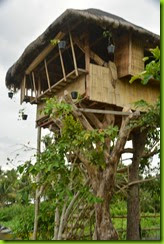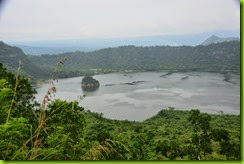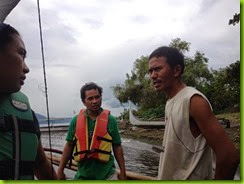For many tourists the once saltwater Taal Lake can be most conveniently seen from far Tagaytay ridge. But there is also its less seen, less traveled side. 
Most famous for its volcano, reportedly one of the “smallest” in the world, the caldera has about 42 known craters, including a huge submerged one and the main crater containing the “lake within a lake”. Until the 1700s, the Pansipit River, which connects the lake to Balayan Bay, was deep enough to enable Chinese trading ships to navigate from one to the other. A series of volcanic eruptions culminating in 1764 severely constricted the breadth and depth of Pansipit River causing the lake to become freshwater.
 My wife, daughter and I didn’t consider spending the night at the treehouse near the Taal Lake Conservation Center (TLCC), Barangay Kinalaglagan (literally: where something fell), Municipality of Mataasnakahoy (literally: high branch) as a warning of impending harm until after some thought. But a loose coincidence of names is all they are, thankfully. Despite the ominous descriptions, we found the treehouse private and cozy, and comfortingly safe. Best of all, it offered a tranquil Taal experience like no other. It is also a perfect jump-off point to the main crater.
My wife, daughter and I didn’t consider spending the night at the treehouse near the Taal Lake Conservation Center (TLCC), Barangay Kinalaglagan (literally: where something fell), Municipality of Mataasnakahoy (literally: high branch) as a warning of impending harm until after some thought. But a loose coincidence of names is all they are, thankfully. Despite the ominous descriptions, we found the treehouse private and cozy, and comfortingly safe. Best of all, it offered a tranquil Taal experience like no other. It is also a perfect jump-off point to the main crater.
In evolutionary terms 300 years is a short time. Even so, over 80 extant endemic and migratory finfish species were able to adapt to the freshwater environment. Possibly the most known of the endemic species because of its high commercial value is the tawilis (sardinella tawilis), a freshwater sardine found only in Taal Lake that greatly contributes to the economy and food supply of the area. Next in importance are the two migratory species of jacks, the muslo  (caranx sexfasciatus) and maliputo (caranx ignobilis), not because they are less preferred but because they are rarer and more difficult to harvest in commercial quantities. These migratory variants of their ocean-going cousins swim to the lake as juveniles to mature into adults and go back to the sea to spawn, traversing the Pansipit River in both instances. The river is the lake’s only connection to the sea.
(caranx sexfasciatus) and maliputo (caranx ignobilis), not because they are less preferred but because they are rarer and more difficult to harvest in commercial quantities. These migratory variants of their ocean-going cousins swim to the lake as juveniles to mature into adults and go back to the sea to spawn, traversing the Pansipit River in both instances. The river is the lake’s only connection to the sea.
But there are niggling problems that threaten the fragile ecosystem.
 On our boat ride en route to Pansipit River, Pusod Executive Director Ann Hazel Javier pointed out some fishpens near Talisay town. Tilapia (oreochromis niloticus or nile tilapia) fishpens were introduced into the lake in 1971, and in Pansipit River in 1988. Some escaped and the omnivore is now found everywhere in the lake. Efforts to contain the proliferation of fishpens came a little late, but have scored some notable successes. From a high of 14,000 fishpens in 2009, the total was brought down to the current 5,000. Also, as of 2011, all the fishpens in the Pansipit River have been removed.
On our boat ride en route to Pansipit River, Pusod Executive Director Ann Hazel Javier pointed out some fishpens near Talisay town. Tilapia (oreochromis niloticus or nile tilapia) fishpens were introduced into the lake in 1971, and in Pansipit River in 1988. Some escaped and the omnivore is now found everywhere in the lake. Efforts to contain the proliferation of fishpens came a little late, but have scored some notable successes. From a high of 14,000 fishpens in 2009, the total was brought down to the current 5,000. Also, as of 2011, all the fishpens in the Pansipit River have been removed.
Leading the efforts to sustainably manage Taal Lake is Pusod, an NGO working with Taal Lake  communities, and the KMMLT (Kilusan ng Maliliit na Mangingisda sa Lawa ng Taal), an association of small-scale fisherfolk coming from the 13 lakeshore municipalities and 3 cities. Both are prominent members of Taal Volcano Protected Landscape Protected Area Management Board (TVPL-PAMB), which is spearheading efforts on the lake’s sustainable use.
communities, and the KMMLT (Kilusan ng Maliliit na Mangingisda sa Lawa ng Taal), an association of small-scale fisherfolk coming from the 13 lakeshore municipalities and 3 cities. Both are prominent members of Taal Volcano Protected Landscape Protected Area Management Board (TVPL-PAMB), which is spearheading efforts on the lake’s sustainable use.
Maan, one of the KMMLT members trained to be a tour guide, answered our initial questions about Taal with authority upon our arrival while serving us sumang haba (rice cakes wrapped in banana leaves and cooked in coconut milk) and kapeng barako (Batangas brewed coffee). Bits of data seemed always at her fingertips, ready to be dished out when appropriate. We were later joined by Ipat Luna, Pusod board member, who took us to the TLCC’s diorama of the lake for a visual presentation of its geography and issues.
There are other invasive species in the lake apart from the Nile tilapia that either compete with endemic species for food or prey on them, or both. There is the Chinese soft-shelled turtle (pelodiscus sinensis), also an omnivore. The presence of “jaguar guapote” (Parachromis  managuensis ), a piscivorous cichlid from Central America found in the aquarium trade, has also been reported.
managuensis ), a piscivorous cichlid from Central America found in the aquarium trade, has also been reported.
As luck would have it, our visit coincided with that of the group from the University of Santo Tomas led by Dr. Rey Donne Papa who has just embarked on a two-year study of the lake. While there have been a slew of studies on Taal since 1904, there remains a dearth of materials with respect to the specific aspects of the life cycle of lake’s many species, save perhaps for the tawilis. Hopefully his study will help policy makers formulate strategies particularly in controlling the proliferation of invasive species.
As we trekked towards the main crater, Ann pointed to one of two incongruous elementary schools in the island serving the communities in the area that has been declared a permanent danger zone. If nothing else, it shows the policies some politicians fecklessly advocate only to undermine them through their action or inaction in the name of political accommodation. 
The view of the highly sulfurous crater lake was imposing. And threatening. Smoke was rising out of several vents, a sign that the volcano is restive. With the activity of some volcanoes in the pacific rim of late, most notably that of Mayon Volcano a month ago, we were worried for the settlers in the island. Evacuation to a safe distance in case of a sudden eruption may take several days.
 Perhaps no other group is more aware of the precarious state of Taal’s fishing industry than the KMMLT. It actively supports the lake’s 1,300 hectare fish sanctuary through regular patrols, in the hope of increasing the tawilis population. With the help of Pusod, the KMMLT has been encouraging its members to explore other sources of livelihood, recognizing that the lake’s fishing industry may have already reached its limit. Tour guiding, beekeeping, and food service are some of the trades the KMMLT members are being trained in, with most of it happening at the TLCC. We’ve been told that the honey they make is being sold almost as fast as the bees can produce it thanks to the patronage of The Farm at San Benito, an upscale resort operating in nearby Lipa City that engages the KMMLT’s services regularly for tours. We wanted to sample some of the honey vinaigrette but
Perhaps no other group is more aware of the precarious state of Taal’s fishing industry than the KMMLT. It actively supports the lake’s 1,300 hectare fish sanctuary through regular patrols, in the hope of increasing the tawilis population. With the help of Pusod, the KMMLT has been encouraging its members to explore other sources of livelihood, recognizing that the lake’s fishing industry may have already reached its limit. Tour guiding, beekeeping, and food service are some of the trades the KMMLT members are being trained in, with most of it happening at the TLCC. We’ve been told that the honey they make is being sold almost as fast as the bees can produce it thanks to the patronage of The Farm at San Benito, an upscale resort operating in nearby Lipa City that engages the KMMLT’s services regularly for tours. We wanted to sample some of the honey vinaigrette but  that too was sold out.
that too was sold out.
Maribel Orense, President of the KMMLT Chapter in Mataasnakahoy, can be seen darting from table to kitchen at the TLCC, which despite the damage wrought by typhoon Glenda on July 15 of this year still managed to host two dining tables, one for us and another for Dr. Papa’s group. And if there is one thing that is really worth going back for, it’s the food — so deliciously unique to Taal that my belly keeps reminding me of it.
 Typhoon Glenda badly damaged the TLCC. Walls were torn away, roofing flew, and nothing but the base of other structures were left. Originally built with the help of the Municipal Government of Mataasnakahoy, the KMMLT and Pusod are still struggling to rebuild it several months after.
Typhoon Glenda badly damaged the TLCC. Walls were torn away, roofing flew, and nothing but the base of other structures were left. Originally built with the help of the Municipal Government of Mataasnakahoy, the KMMLT and Pusod are still struggling to rebuild it several months after.
We saw fireflies, said to be bioindicators of a healthy ecosystem, inside the treehouse as we were preparing to sleep. There is hope for Taal yet.
[Some photos courtesy of Pusod, Inc.}